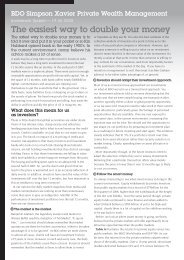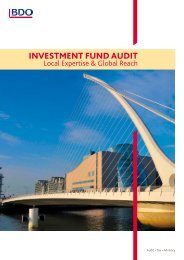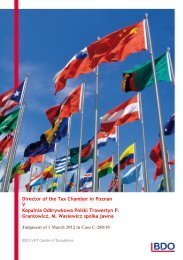need to know / leases - project update - BDO International
need to know / leases - project update - BDO International
need to know / leases - project update - BDO International
You also want an ePaper? Increase the reach of your titles
YUMPU automatically turns print PDFs into web optimized ePapers that Google loves.
8 LEASES - A PROJECT UPDATE<br />
SCOPE<br />
The proposed scope means that the new requirements would apply <strong>to</strong> all <strong>leases</strong> (including sub<strong>leases</strong>) except for:<br />
––<br />
Leases for the right <strong>to</strong> explore for or use minerals, oil, natural gas and similar non-regenerative resources<br />
––<br />
Leases of biological assets<br />
––<br />
Leases of service concession arrangements within the scope of IFRIC 12 Service Concession Arrangements<br />
––<br />
Short term <strong>leases</strong> (these are <strong>leases</strong> with a maximum possible term, including any options <strong>to</strong> renew, of 12 months or less).<br />
This means that <strong>leases</strong> of noncore assets (that is, assets not related <strong>to</strong> an entity’s main business activities), and long term <strong>leases</strong><br />
of land, would be within the scope of the proposals. In addition, there is no scope exclusion for assets that are often treated as<br />
inven<strong>to</strong>ry, such as non-depreciating spare parts, operating materials, and supplies, if these are associated with the leasing of<br />
another underlying asset. This may represent a significant further change for some entities.<br />
Although not specifically within the scope of the proposals, intangible assets are noted as not being required <strong>to</strong> be accounted<br />
for in accordance with the <strong>leases</strong> standard. This means that it would appear that an entity will have an option <strong>to</strong> apply the new<br />
requirements <strong>to</strong> <strong>leases</strong> of intangibles. It is not yet clear whether the approach adopted would <strong>need</strong> <strong>to</strong> be applied <strong>to</strong> all leased<br />
intangibles, or whether an entity would have a choice on an individual leased asset basis.<br />
CONTRACTS THAT CONTAIN LEASE AND<br />
NON-LEASE COMPONENTS<br />
For contracts that contain lease and non-lease components, the proposals would require each component <strong>to</strong> be identified<br />
and accounted for separately.<br />
A lessee would allocate payments due under the overall contract as follows:<br />
––<br />
If the purchase price of each component is observable, the lessee would allocate the payments on the basis of the relative<br />
purchase prices of individual components.<br />
––<br />
If the purchase price of one or more, but not all, of the components is observable, the lessee would allocate the payments<br />
on the basis of a residual method.<br />
––<br />
If there are no observable purchase prices, the lessee would account for all the payments required by the contract as a<br />
lease.<br />
Application guidance is <strong>to</strong> be included in the proposals, <strong>to</strong> assist lessees in determining what is meant by an ‘observable<br />
price’. This will take account of guidance that is planned <strong>to</strong> be included in other <strong>project</strong>s, in particular for revenue recognition.<br />
A lessor would allocate payments <strong>to</strong> be received in accordance with the guidance on revenue recognition.


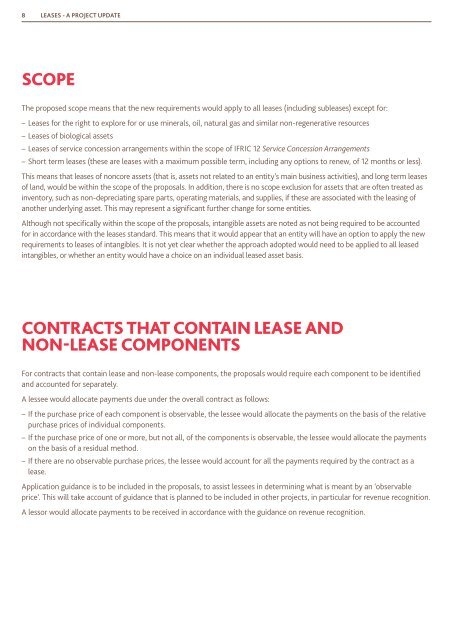

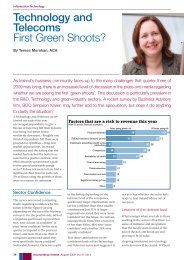



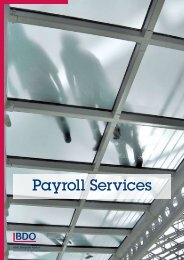
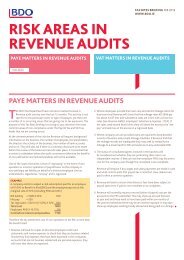
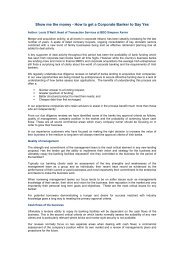
![eii 2013 a5 2pp flyer [web].pdf - BDO](https://img.yumpu.com/39595753/1/184x260/eii-2013-a5-2pp-flyer-webpdf-bdo.jpg?quality=85)
